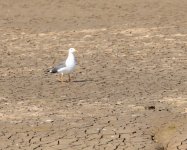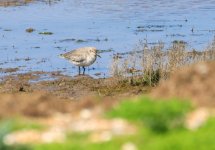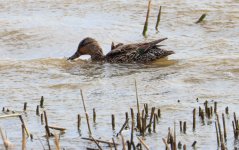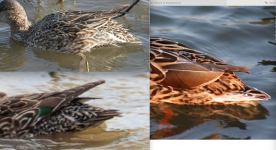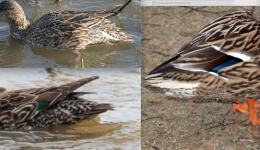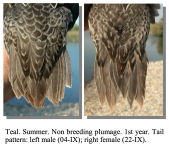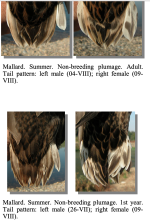This one does show a white stripe ahead of the tail, exactly where it should be on a teal. The bill pattern is wrong for a mallard. The extent of visible orange is a bit more than I've seen on most teals (at least on this side of the pond), but it follows the teal pattern (base of bill plus "lips", in teals that show any orange at all). That's not hugely different from the gadwall pattern, but I'm ruling out gadwall based on the speculum.
Honestly, I had an immediate (and probably premature) reaction of "that's not a mallard" just based on the degree of contrast within individual body feathers, before I enlarged the photo to see the bill or speculum. You usually don't see that much in-feather contrast on mallards, though that's mostly because you don't usually see birds with their feathers in such disarray.
To ID a bird, you need to find a combination of traits that cannot occur in any other (local) species. That's hard to summarize, especially since you have to consider non-breeding males.
For birds that look vaguely like female mallards, the first thing I look for is the tail. Mallards (including nonbreeding males, though not including all domestic breeds) will have easily visible white on at least the outer tail feathers. That's not exclusive to mallards but it helps narrow things down.
Next I'll check for a speculum. A speculum is not always visible (may be covered by other feathers) and doesn't always catch the light, but if you do see one, note the color and whether it has any border. A mallard speculum should be blue-purple and have a black-and-white border (with white on the outside) on both front and back. (The border is not always obvious, and the front border may be covered, but if you see a different color border, or a different border shape, you should suspect something other than a mallard. For example, mottled duck has an all-black border; Green-winged teal has a black border at top and bottom of the speculum, with a very thin white border at the back edge that is not always apparent; gadwall has an all-white speculum.
Third, many species have distinctive bills. Female mallards typically have a saddle-shaped dark spot on a bill that may vary from orange to olive (again, domestic breeds can mess this up); female gadwalls have a dark "racing stripe" down the top of an orangish bill. (Non-breeding male gadwalls have a bill similar to females, but darker.)
That should narrow the suspects enough to look for signs that support one particular species. Teals are small, female pintails have all-black bills and very plain heads, etc.




